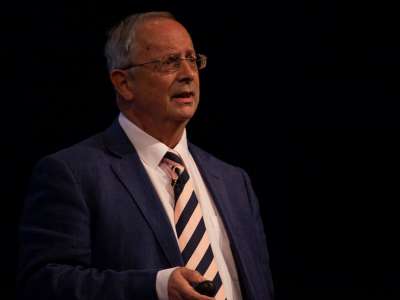
The interdisciplinarity of seating: marrying the values of users, engineers and therapists. Where in the world are we going?
To summarise the lecture given by Dr Barend ter Haar (co-founder and managing director of BES Healthcare and BHTA lifetime achievement award winner) would take far more words than I have space for. Since I will be focusing on two areas of the talk in particular, I strongly recommend watching the webcast on the PMG website to get the full benefit of the information Barend shared.
Barend has been working with the International Organization for Standardization (ISO) for many years and, during his talk, he provided a “taster menu” of many important standards that the ISO has been developing. From shear guidelines to flammability to Get Wise to Flying to placement of positioning belts, he provided a wealth of information to spark discussion with the team at my clinic. Most contentious by far were the standards for Velcro fastening, especially whether hook or loop should be on the cushion/wheelchair upholstery.
Having travelled around the world meeting engineers and other professionals, Barend provided a unique look into the mobility challenges faced in developing countries. For example he explained that, while we in the UK prefer aluminium frames, in some countries steel and bamboo may be preferable materials to use for ease of repairs in more remote locations with fewer resources.
Unsurprisingly then, one of the primary focuses of the talk was WHO GATE (World Health Organization: Global Cooperation on Assistive Technology), whose primary goal is “improving access to high-quality affordable assistive technology globally”. The group has developed the Priority Assistive Products List that covers mobility, vision, hearing, communication, cognition and environment. Given the increased quality of life and independence that even the most basic of assistive technologies can provide people I find it encouraging, as an assistive technology (AT) professional, that an international body has recognised how essential AT is to global health solutions.
WHO GATE has published five position papers based around the five areas they have recognised as their primary focus (my summary below):
- People – working closely with end users to ensure that not only functional but cultural needs are addressed
- Provision – guidelines on global good-practice for integration of assistive technology into the health system
- Personnel – providing training to ensure that countries have the calibre of workers necessary to provide appropriate equipment
- Policy – development of a toolkit that will provide guidelines on financing, minimum standards, training and provision
- Products – encouraging countries to develop their own priority assistive products list, tailored to the needs of their users, to enhance production and procurement of technology
Of all the fascinating aspects of the WHO GATE initiative, the one that most captured my interest is the development of the Wheelchair Service Training Packages. These packages provide training to healthcare professionals at different skill levels to improve provision of seating and mobility devices.
Ever since I decided to specialise in wheelchairs, when I’m travelling in some other countries, I cannot help but notice accessibility limitations, inadequate postural support and other barriers faced by persons with disabilities. While it is important for us to promote change on a local level, looking into WHO GATE has reminded me that, if possible, as clinicians we need to think more globally sometimes. For those interested, anyone can join the GATE community to keep up-to-date with global initiatives; click here for more information.
When addressing assistive technology provision, WHO GATE suggests moving away from a strict medical model by increasing user involvement in AT decisions and goal setting. Similarly, another focus of Barend’s talk was how international standards are now moving towards integrating the needs of prescribers and users with the priorities of engineers. In February 2018 the ISO published an Annex B to wheelchair seating standard 16840-2, which determines the physical and mechanical characteristics of seat cushions. This document provides a link between engineering values and clinical outcomes, such as sliding resistance in newtons or the tendency to slide out of position on a particular cushion cover. This links to a broader area that is being worked on – Quality Functional Deployment (QFD). The goal of QFD is to link the quality requirements of the user (comfort, ulcer prevention, style, lightness, etc.) with the engineering characteristics (mass, envelopment, heat transfer, etc.). The goal is to create a matrix that correlates the quality requirements with engineering characteristics and construction technologies. They are currently working with wheelchair users in the United States through the Food and Drug Administration and the Department of Veterans Affairs, but are seeking volunteers internationally to gather enough data to create cushion guidelines for different groups of end users.
On reflection, I found the QFD part of the talk particularly thought-provoking, as it focused on the need to look more closely at how the user interacts with the assistive technology, and how that relates to possible changes in manufacturing. Having an understanding of the underlying characteristics of different materials is vital to successful provision. I can think of a small group of my clients with multiple sclerosis who report that, despite trialling various cushions, they can only independently laterally transfer with a certain manufacturer’s basic cushion with nylon cover; if this product was no longer available, knowing what characteristics to look for in another cushion/cover would be invaluable. While I do not think that there will ever be a matrix that would ensure the right cushion first time for every client, a more thorough database would be a significant resource.
As clinicians working with end users on a daily basis, we see the trends in successes and failures of different equipment. I want to thank Barend for reminding me how important it is to collect data and liaise with manufacturers to improve outcomes for our clients.
Photograph is of Dr Barend ter Haar giving his presentation at PMG 2018 in Manchester






.jpg)



no comments
Add your comment...